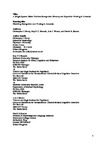A single-system model predicts recognition memory and repetition priming in amnesia
| dc.contributor.author | Berry, CJ | |
| dc.contributor.author | Kessels, RPC | |
| dc.contributor.author | Wester, AJ | |
| dc.contributor.author | Shanks, DR | |
| dc.contributor.editor | Maunsell J | |
| dc.date.accessioned | 2015-02-25T10:06:55Z | |
| dc.date.available | 2015-02-25T10:06:55Z | |
| dc.date.issued | 2014-08-13 | |
| dc.identifier.issn | 0270-6474 | |
| dc.identifier.issn | 1529-2401 | |
| dc.identifier.uri | http://hdl.handle.net/10026.1/3267 | |
| dc.description.abstract |
We challenge the claim that there are distinct neural systems for explicit and implicit memory by demonstrating that a formal single-system model predicts the pattern of recognition memory (explicit) and repetition priming (implicit) in amnesia. In the current investigation, human participants with amnesia categorized pictures of objects at study and then, at test, identified fragmented versions of studied (old) and nonstudied (new) objects (providing a measure of priming), and made a recognition memory judgment (old vs new) for each object. Numerous results in the amnesic patients were predicted in advance by the single-system model, as follows: (1) deficits in recognition memory and priming were evident relative to a control group; (2) items judged as old were identified at greater levels of fragmentation than items judged new, regardless of whether the items were actually old or new; and (3) the magnitude of the priming effect (the identification advantage for old vs new items) overall was greater than that of items judged new. Model evidence measures also favored the single-system model over two formal multiple-systems models. The findings support the single-system model, which explains the pattern of recognition and priming in amnesia primarily as a reduction in the strength of a single dimension of memory strength, rather than a selective explicit memory system deficit. | |
| dc.format.extent | 10963-10974 | |
| dc.format.medium | ||
| dc.language | en | |
| dc.language.iso | en | |
| dc.publisher | Society for Neuroscience | |
| dc.subject | amnesia | |
| dc.subject | computational model | |
| dc.subject | long-term memory | |
| dc.subject | memory systems | |
| dc.subject | recognition memory | |
| dc.subject | repetition priming | |
| dc.title | A single-system model predicts recognition memory and repetition priming in amnesia | |
| dc.type | journal-article | |
| dc.type | Article | |
| plymouth.author-url | https://www.ncbi.nlm.nih.gov/pubmed/25122896 | |
| plymouth.issue | 33 | |
| plymouth.volume | 34 | |
| plymouth.publication-status | Published | |
| plymouth.journal | The Journal of Neuroscience | |
| dc.identifier.doi | 10.1523/JNEUROSCI.0764-14.2014 | |
| plymouth.organisational-group | /Plymouth | |
| plymouth.organisational-group | /Plymouth/Faculty of Health | |
| plymouth.organisational-group | /Plymouth/Faculty of Health/School of Psychology | |
| plymouth.organisational-group | /Plymouth/REF 2021 Researchers by UoA | |
| plymouth.organisational-group | /Plymouth/REF 2021 Researchers by UoA/UoA04 Psychology, Psychiatry and Neuroscience | |
| plymouth.organisational-group | /Plymouth/Users by role | |
| plymouth.organisational-group | /Plymouth/Users by role/Academics | |
| dc.publisher.place | United States | |
| dc.identifier.eissn | 1529-2401 | |
| dc.rights.embargoperiod | Not known | |
| rioxxterms.versionofrecord | 10.1523/JNEUROSCI.0764-14.2014 | |
| rioxxterms.licenseref.uri | http://www.rioxx.net/licenses/all-rights-reserved | |
| rioxxterms.type | Journal Article/Review |


